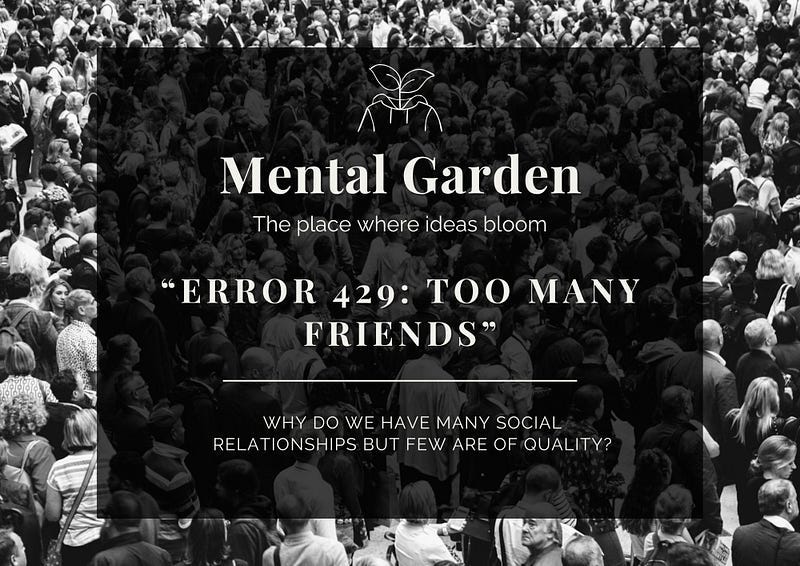🏷️ Categories: Attention, Social relationships, Memory
Introduction
We find ourselves immersed in a world where social relationships have exponentially multiplied thanks to technology, if we compare with the number of contacts someone could have had a century ago or even further back.
This raises a question: Why, despite being more connected than ever, can the number of high-value relationships still be counted on one hand? If we know so many more people, shouldn’t we then have a larger network of important individuals?
I invite you to reflect on this question, which will lead us to appreciate more the time we have, the importance of memory, attention, and the role that social networks play in the current era.
Dunbar’s number
The Dunbar number is our first stop on this journey. Proposed by psychologist Robin Dunbar, the number represents the theoretical limit of people with whom we can maintain stable social relationships that are meaningful and don’t just end with a simple “hello” and “goodbye” — roughly about 150 individuals. This figure, although variable, provides a general idea of our cognitive capacity to manage valuable social connections.
It is based on the premise that even though modes of communication have changed significantly recently, the size of our brains has not, leading to the thought that there may be a cognitive limitation on the number of face-to-face social interactions (Dunbar, 1993; Roberts et al., 2009).
150 is the average number at any given time, but we haven’t always had the same friends. When a new friendship is formed, it’s quite likely that an old one will be discarded, especially if we already have a high number of contacts. The less close the relationship, the more likely it is to be replaced by someone else (Saramäki et al., 2014; Sutcliffe et al., 2011).
🔎 In detail: 150 is a reference point and depends heavily on what we consider to be a significant and stable relationship. There are studies suggesting an average size of personal networks of 291 for Americans (Killworth et al., 1998; McCarty et al., 2001). This is because culture and technology, among other factors, facilitate socialization (De Ruiter et al., 2011). For this reason, its validity is still debated today.
Internet and Dunbar’s number
Scarce resources
Okay, 150 is an approximate value that can vary considerably among individuals, but there are two evident things:
1. Time is a limited resource.
2. The attention we give to environmental stimuli is limited.
We have to prioritize what to spend our time on and what to pay attention to; these conditions have not changed throughout our evolution. However, with the emergence of social networks, the capacity to connect with people has been drastically increased while time and attention have not.
The time we have to invest in relationships is an important limitation regarding their quality (Roberts et al., 2009; Ackerman et al., 2007), and emotional closeness in friendships deteriorates when the frequency of interactions decreases (Roberts & Dunbar, 2011). This leads us to consider two options:
Increase the number of relationships but they are more superficial (lower quality).
Reduce the number of relationships but they are closer (higher quality).
The great change brought by social network
We have scarce resources, but social networks make it possible to expand our network of contacts because they facilitate two aspects:
1. Memory and knowledge management: Essentially, maintaining friendships requires staying up to date with what they are doing and sharing experiences with them. Many relationships are based on sharing interests and knowledge (McPherson et al., 2001). In this aspect, social networks allow us to follow activities and opinions of friends in circumstances where it wouldn’t be possible face-to-face (for example, because they have moved far away) (Donath, 2007), thus preventing the relationship from declining (Roberts & Dunbar, 2015).
2. Dissemination: Physical interaction is limited to a small number of individuals at any given time (Dunbar et al., 1995). For example, nobody meets with 50 friends in a park for a chat. This inevitably limits the social time available for close relationships (Ackerman et al., 2007). In social networks and messaging, the limit is practically non-existent; we can simultaneously talk to huge groups of people with the same level of intensity.
The good and the bad of social networks
The good aspect is that social networks have expanded the number of contacts, which seems positive because we can create and maintain a greater number of close relationships (Bargh & McKenna, 2004; Valkenburg & Peter, 2009), increasing our well-being because they are less demanding than other means of communication such as face-to-face interaction (Valkenburg & Peter, 2007; Boneva et al., 2006).
The bad aspect is that establishing new valuable relationships online is less likely than in person (Boyd & Ellison, 2007), and less satisfying, as they are cognitively impoverished. In other words, we receive auditory stimulation if it’s a call, visual if it’s text, but we don’t perceive the interaction with all our senses. Video calling is the closest thing to face-to-face interaction, which is why it’s the most satisfying medium among virtual ones. Remember during the COVID-19 restrictions, how pleasant a video call was to alleviate the feeling of isolation. On the other hand, returning to the initial question of time, Nie (2001), over 20 years ago, argued that since time is limited, the more time we dedicate to online relationships, the less we have for face-to-face socializing, especially with family. I believe that time has proven him right; just look at how younger people and to some extent adults spend their time. See also Nie & Hillygus (2002).
The example of Twitter
A clear example of how having more relationships implies lower quality was seen in an interesting study that analyzed 3.7 million messages from Twitter threads of about 1.7 million users (Gonçalves et al., 2011). The study analyzed the interconnections between these user profiles and arrived at the following result:

The result is clear:
For figure A), Between 100 and 200 contacts is the range in which we can maintain the highest number of social interactions with each one. As we have more contacts, we send fewer messages on average to each, with the implications we saw regarding the quality of relationships.
For figure B), the higher the number of contacts sending us messages, the lower our ability to respond to all of them. Beyond 300 contacts, we are no longer able to respond with the same intensity as they message us, which deteriorates the relationship.
🔎 In detail: One could argue that Twitter is not precisely the ideal social network for establishing close relationships due to its design, and we would need to see what happens in others like Facebook, WhatsApp, or perhaps Instagram. Nevertheless, in any case, it continues to be demonstrated that more is less, even though Twitter is the best of all for sharing opinions and having dissemination, aspects that, as we have seen, are essential for building good relationships.
Conclusion
Regardless of the maximum number, whether it’s 150 or 300, what is clear is that the intense interconnection of today allows us to have more relationships than ever before, but not necessarily of higher quality than in the past. Psychologically, virtual interaction often does not generate more well-being, and in fact, it can easily worsen it if social media and time are misused. More does not equal better; it’s a matter of prioritizing quality over quantity of interactions.
It’s time to set aside time to meet with that friend you always say “let’s meet up someday,” it’s time to share experiences with those you love the most and not just share Instagram stories with them, it’s time to build trust, intimacy, and help friends who will help you when you need someone, it’s time to enjoy more.
📚 References
Ackerman, J. M., Kenrick, D. T., & Schaller, M. (2007). Is friendship akin to kinship? Evolution And Human Behavior, 28(5), 365–374. https://doi.org/10.1016/j.evolhumbehav.2007.04.004
Bargh, J. A., & McKenna, K. y. A. (2004). The Internet and Social Life. Annual Review Of Psychology, 55(1), 573–590. https://doi.org/10.1146/annurev.psych.55.090902.141922
Boneva, B., Quinn, A., Kraut, R. E., Kiesler, S., & Shklovski, I. (2006). Teenage Communication in the Instant Messaging Era. En Oxford University Press eBooks (pp. 201–218). https://doi.org/10.1093/acprof:oso/9780195312805.003.0014
Boyd, D., & Ellison, N. B. (2007). Social Network Sites: Definition, History, and Scholarship. Journal Of Computer-Mediated Communication, 13(1), 210–230. https://doi.org/10.1111/j.1083-6101.2007.00393.x
De Ruiter, J., Weston, G., & Lyon, S. M. (2011). Dunbar’s Number: Group Size and Brain Physiology in Humans Reexamined. American Anthropologist, 113(4), 557–568. https://doi.org/10.1111/j.1548-1433.2011.01369.x
Donath, J. (2007). Signals in Social Supernets. Journal Of Computer-Mediated Communication, 13(1), 231–251. https://doi.org/10.1111/j.1083-6101.2007.00394.x
Dunbar, R. (2012). Social cognition on the Internet: testing constraints on social network size. Philosophical Transactions Of The Royal Society B, 367(1599), 2192–2201. https://doi.org/10.1098/rstb.2012.0121
Dunbar, R. I. M. (1993). Coevolution of neocortical size, group size and language in humans. Behavioral And Brain Sciences, 16(4), 681–694. https://doi.org/10.1017/s0140525x00032325
Dunbar, R., Duncan, N., & Nettle, D. (1995). Size and structure of freely forming conversational groups. Human Nature, 6(1), 67–78. https://doi.org/10.1007/bf02734136
Gonçalves, B., Perra, N., y Vespignani, A. (2011). Modeling Users’ Activity on Twitter Networks: Validation of Dunbar’s Number. PLOS ONE, 6(8), e22656. https://doi.org/10.1371/journal.pone.0022656
Killworth, P. D., McCarty, C., Bernard, H. R., Shelley, G. A., & Johnsen, E. C. (1998). Estimation of Seroprevalence, Rape, and Homelessness in the United States Using a Social Network Approach. Evaluation Review, 22(2), 289–308. https://doi.org/10.1177/0193841x9802200205
McCarty, C., Killworth, P. D., Bernard, H. R., Johnsen, E. C., & Shelley, G. A. (2001). Comparing Two Methods for Estimating Network Size. Human Organization, 60(1), 28–39. https://doi.org/10.17730/humo.60.1.efx5t9gjtgmga73y
McPherson, M., Smith‐Lovin, L., y Cook, J. (2001). Birds of a Feather: Homophily in Social Networks. Annual Review Of Sociology, 27(1), 415–444. https://doi.org/10.1146/annurev.soc.27.1.415
Nie, N. H. (2001). Sociability, Interpersonal Relations, and the Internet. American Behavioral Scientist, 45(3), 420–435. https://doi.org/10.1177/00027640121957277
Nie, N. H. & Hillygus, D. S. 2002 The impact of internet use on sociability: time-diary findings. IT Soc. 1, 1–20. https://www.researchgate.net/publication/247901330_The_Impact_of_Internet_Use_on_Sociability_Time-Diary_Findings
Roberts, S. G. B., y Dunbar, R. (2011). The costs of family and friends: an 18-month longitudinal study of relationship maintenance and decay. Evolution And Human Behavior, 32(3), 186–197. https://doi.org/10.1016/j.evolhumbehav.2010.08.005
Roberts, S. G. B., & Dunbar, R. (2015). Managing relationship decay. Human Nature, 26(4), 426–450. https://doi.org/10.1007/s12110-015-9242-7
Roberts, S. G. B., Dunbar, R., Pollet, T. V., & Kuppens, T. (2009). Exploring variation in active network size: Constraints and ego characteristics. Social Networks, 31(2), 138–146. https://doi.org/10.1016/j.socnet.2008.12.002
Saramäki, J., Leicht, E., López, E., Roberts, S. G. B., Reed‐Tsochas, F., & Dunbar, R. (2014). Persistence of social signatures in human communication. Proceedings Of The National Academy Of Sciences Of The United States Of America, 111(3), 942–947. https://doi.org/10.1073/pnas.1308540110
Sutcliffe, A., Dunbar, R., Binder, J. F., & Arrow, H. (2011). Relationships and the social brain: Integrating psychological and evolutionary perspectives. British Journal Of Psychology, 103(2), 149–168. https://doi.org/10.1111/j.2044-8295.2011.02061.x
Valkenburg, P. M., & Peter, J. (2007). Online Communication and Adolescent Well-Being: Testing the Stimulation Versus the Displacement Hypothesis. Journal Of Computer-Mediated Communication, 12(4), 1169–1182. https://doi.org/10.1111/j.1083-6101.2007.00368.x
Valkenburg, P. M., & Peter, J. (2009). Social Consequences of the Internet for Adolescents. Current Directions In Psychological Science, 18(1), 1–5. https://doi.org/10.1111/j.1467-8721.2009.01595.x






